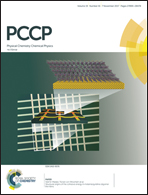Spin labelling for integrative structure modelling: a case study of the polypyrimidine-tract binding protein 1 domains in complexes with short RNAs†
Abstract
A combined method, employing NMR and EPR spectroscopies, has demonstrated its strength in solving structures of protein/RNA and other types of biomolecular complexes. This method works particularly well when the large biomolecular complex consists of a limited number of rigid building blocks, such as RNA-binding protein domains (RBDs). A variety of spin labels is available for such studies, allowing for conventional as well as spectroscopically orthogonal double electron–electron resonance (DEER) measurements in EPR. In this work, we compare different types of nitroxide-based and Gd(III)-based spin labels attached to isolated RBDs of the polypyrimidine-tract binding protein 1 (PTBP1) and to short RNA fragments. In particular, we demonstrate experiments on spectroscopically orthogonal labelled RBD/RNA complexes. For all experiments we analyse spin labelling, DEER method performance, resulting distance distributions, and their consistency with the predictions from the spin label rotamers analysis. This work provides a set of intra-domain calibration DEER data, which can serve as a basis to start structure determination of the full length PTBP1 complex with an RNA derived from encephalomycarditis virus (EMCV) internal ribosomal entry site (IRES). For a series of tested labelling sites, we discuss their particular advantages and drawbacks in such a structure determination approach.



 Please wait while we load your content...
Please wait while we load your content...